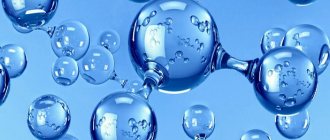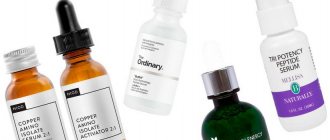beauty
31 August 2020, 19:17
- Main action of AHA
- Why is citric acid added to cosmetics?
- The effect of citric acid on the skin
Almost no cosmetic product is complete without fruit acids - malic, lactic, tartaric, citric. They work simultaneously on the surface of the epidermis and in the cells, and have powerful exfoliating, whitening, rejuvenating, and antibacterial properties. What effect does citric acid have, why is it added to cosmetics?
Main action of AHA
Usually, creams, peels, and serums contain not one, but several varieties of fruit acids (AHA). They enhance each other’s effectiveness, allowing the product to work in several directions: gentle exfoliation, cleansing pores, combating age-related changes, lightening age spots.
As a rule, cosmetics with AHAs are used for evening care, as they increase the skin's sensitivity to sunlight
If such products are used in day care, then sunscreen should be applied to the face.
Citric acid is a type of fruit acid
D-Limonene
| Imported solvents of low toxicity | ||
| Substance: | D-limonene | |
| Synonyms: | Limonen-D Limonene, D-Limonene (Orange terpenes) | |
CAS catalog number:
5989-27-5
EINECS-No.:
5989-27-5
Description
D-limonene is a widespread terpene hydrocarbon, which is the main component of orange peel oil (up to 80-90%). It is also found in almost all citrus fruits and many other essential oils: lemon, tangerine, lime, grapefruit, bergamot, neroli, petitgrain, elemi, caraway, dill, fennel, parsley, erigeron, orthodone. d-Limonene is obtained by fractional distillation of mixtures of terpenes formed during their isolation from citrus essential oils. Currently, the annual production of d-limonene in the world reaches 70 thousand tons and continues to grow rapidly.
It is an optical isomer of L-Limonene; previously they were not separated and were considered one substance, dipentene. Together, these isomers cause the smell of gum turpentine. Unlike D-Limonene, the odor of L-limonene has a pronounced pine smell; this enantiomer is also used as a fragrance. Its possible carcinogenic properties of L-Limonene are discussed.
Despite many laudatory articles about the naturalness of the product, d-limonene is dangerous; in addition to the burning effect on the skin and mucous membranes, it causes allergic reactions. In general, at the moment its effect on the body in industrial concentrations is equated to acetone. But the consumer does not encounter a concentrated product, and when diluted it is the safest. Another advantage over industrial solvents is its rapid and complete biodegradability. But it is still dangerous for the environment, and is a substance classified as a flammable liquid (vapors mixed with air) that can ignite and explode.
To support my words, I provide an excerpt from the MSDS for this substance.
The main advantages of the product are a pleasant lemon smell, which creates the illusion of its safety, and a very wide range of compounds that it is capable of dissolving.
Soluble in alcohol, fatty and mineral oils, kerosene, acetone, dimethyl sulfoxide, diethyl ether, insoluble in water, propylene glycol, glycerin.
Physical properties of d-limonene
| INCI: | Limonene |
| CAS No.: | 5989-27-5 |
| EINECS-No.: | 5989-27-5 |
| FEMA: | 2633 |
| Gross formula: | С10H16 |
| Molecular mass: | 136,24 |
| Boiling temperature: | 175.5 °C |
| Density: | 0.84 g/cm3 (at 20°C) |
| Appearance: | Transparent, colorless liquid with a pleasant citrus odor. |
Specification for d-limonene
| Indicator name | Analysis results | Quality requirements |
| Description of appearance (color, smell, taste): | Transparent, colorless liquid | |
| Density (at 20 °C): | 0,8417 | 0,840 – 0,848 |
| Refractive index (at 20 °C): | 1,4731 | 1,471 – 1,475 |
| Chromatogram data Aldehydes (in terms of citral): | 0,45 % | |
| Flash point, °C | 51 | |
| Optical rotation (at 20 °C, 1dm, 589 nm): | 100,6° | |
Benefits of d-limonene
- an excellent solvent for fats, waxes, resins, plastics, petroleum products;
- natural aromatic substance with a pleasant smell (for the production of perfume compositions, fragrances and food flavorings);
- intermediate raw materials in chemical synthesis (terpinhydrate, terpineol, carvone, flotation reagents);
- repellent;
- antioxidant;
- disinfectant;
- skin lightening agent. d-Limonene can be used in its pure form, which is dangerous, mixes well with other solvents, and can be easily emulsified to produce water-soluble cleaning products.
Application
d-Limonene is used in a wide variety of industries due to its diverse properties. It is included in many perfume products, shampoos, detergents and cleaning products, solvents - in everyday life and in production. It probably has no competitor when it comes to removing chewing gum marks or stickers from metal, wood or plastic surfaces. d-Limonene is used for degreasing metal before industrial painting, in household chemicals, for example, for cleaning wooden surfaces, and for removing grease from the skin of hands. It is an excellent environmentally friendly alternative to toxic and dangerous solvents and petroleum products such as: acetone, benzene, butyl cellosolve, toluene, trichlorethylene, xylene, methyl ethyl ketone, white spirit, but it costs exactly 30 times more than these solvents, and as I wrote previously, has toxicity, which is disguised as a pleasant smell.
The use of d-limonene as an insecticide is interesting. It appeared because Ohio University entomology professor Fred Hinck discovered poisons that were lethal to fleas in orange peels. D limonene kills adult insects, their larvae and eggs,” he says.
Why is citric acid added to cosmetics?
Citric acid is present in many cosmetic products, and this ingredient is not always listed in the composition. It refers to a type of fruit acid that is obtained from various citrus fruits. Citric acid is often used not for facial care, but as a pH regulator . This component, obtained from citrus fruits, makes the product more acidic (this is especially necessary for toners and cleansers), and is also added to the composition as a natural preservative.
In this case, this ingredient, according to cosmetics labeling rules, is not always indicated on the label. For these purposes, it is added to shampoos, hair conditioners, facial tonics, cleansing gels, creams, and soaps.
Another property of this component is foaming , due to which foams and shampoos foam well. It is also added to hair dyes: it makes the pigment more saturated. Of course, Citric acid is also included in skin care.
Citric acid is often added to the composition as an acidity regulator.
Limonene
The concentration of limonene in cosmetics does not exceed 0.01%, so it is mentioned one of the last in the list of ingredients.
Limonene saturates cosmetics, household chemicals and even medicines with lemon aroma 52119
Properties of limonene used in cosmetics:
Aromatic . Limonene imparts a fresh, light citrus or pine scent to cosmetics and hygiene products.
Solvent . Limonene is an excellent fat dissolver, and therefore is used in the production of cosmetics as a harmless alternative to alcohols.
Disinfectant. Limonene effectively fights fungal and bacterial microorganisms, mold, mites, helping to cleanse the skin and protect cosmetics from spoilage.
Limonene is an effective repellent because it not only repels, but also kills many insects, which is why it is included in ointments and sprays that protect against insect bites.
It is recommended to store cosmetics containing limonene in a cool, dry place.
What cosmetics contain limonene?
- Face and body creams
- Lotions
- Tonics
- Tanning products
- Shampoos, conditioners
- Decorative cosmetics
- Shaving products
- Soap, bubble bath, shower gel
- Decorative cosmetics
- Lipsticks, lip balms
The use of cosmetics with limonene is undesirable:
- for hypersensitive skin
- with a tendency to allergies, especially to citrus and pine components
What is Limonene found in cosmetics?
Limonene is a substance related to terpene hydrocarbons. It was first isolated from the essential oil of orange peels back in the mid-19th century. At first, scientists believed that limonene had many different isomer variants, since this fragrant element was found in the essential oils of bergamot, cumin, lemon, mint, parsley, fennel, pine and many other plants, and even gave these variants different names. But then they came to the conclusion that there are only two varieties of limonene - one is found in citrus oils and smells of lemon freshness, and the other, which has the smell of pine needles, is extracted from turpentine and pine oils (by the way, the term “terpenes” comes from the Latin expression Oleum Terebinthinae, meaning "turpentine").
Limonene is a popular aromatic fragrance for cosmetics, perfumes, hygiene and detergents, and medicines. Despite its flavor variations, limonene is usually referred to as the isomer that smells like lemon.
Due to its degreasing properties, limonene is indispensable in nail polish removers and for removing grease from the skin of the hands. Taking into account modern trends in environmental friendliness, it is becoming very popular to use home care products that leave a fresh, natural citrus scent. And limonene also helps with this, especially since its aroma can create a good mood.
Where do you get limonene for cosmetics?
Limonene can be obtained naturally and synthetically. Since citrus essential oils can contain up to 90% limonene, it can be extracted using centrifugation and fractional steam distillation. However, on an industrial scale, limonene is most often obtained synthetically from geraniol by chemically acting on its hydrocarbon chain.
The result is a viscous, transparent, colorless liquid with a strong lemon odor, which is completely insoluble in water, but easily contacts ethanol.
Limonene raises concerns about allergenicity and carcinogenicity. However, studies have shown that limonene is no more likely to cause allergies than other flavorings, including natural citrus flavors.
As for carcinogenicity, according to the International Agency for Research on Cancer, limonene is classified as a substance from the stable safety zone and is not classified as a carcinogen. Moreover, research is underway on the positive effects of limonene on the body in certain types of tumors.
The effect of citric acid on the skin
The peculiarity of Citric acid is that, due to the large size of its molecules, it works on the surface of the epidermis, having a powerful antibacterial and whitening effect . That is why it is rarely used as the main component: in high concentrations it will irritate the epidermis.
Its main effect is exfoliation of keratinized cells of the epidermis , and therefore most often it can be found in products intended for exfoliation: peelings, rolls, gommages, tonics, washing gels for problematic and oily skin.
Citric acid exfoliates dead cells of the epidermis, evens out the relief, makes pores less noticeable, smoothes scars and marks left after acne.
In professional cosmetology in clinics, the component is used in higher concentrations than in home products to combat serious defects (for example, scars, scars, hyperpigmentation). The substance also works as an antioxidant that fights signs of aging, but this is not its main property.
Citric acid has a strong whitening and exfoliating effect
Basically, cosmetics with this component are intended for oily and problem skin . Like any other fruit acid, it should not be applied daily. If your skin is sensitive, the product may cause irritation.
It is important to understand that Citric acid is not a powdered substance that is used for culinary purposes or for descaling equipment. And this is not pure lemon juice. Neither the first nor the second should categorically be used in care: applying them to the face can cause dryness, irritation, peeling and even burns. Citric acid is a component used in cosmetology. It can only be applied in the form of professional creams, tonics, peelings, serums, and gels for facial cleansing.
Saint Petersburg
d-Limonene is used in a wide variety of industries due to its diverse properties. It is included in many perfume products, shampoos, detergents and cleaning products, solvents - in everyday life and in production. It probably has no competitor when it comes to removing chewing gum marks or stickers from metal, wood or plastic surfaces. d-Limonene is used for degreasing metal before industrial painting, in household chemicals, for example, for cleaning wooden surfaces, and for removing grease from the skin of hands. It is an excellent environmentally friendly alternative to toxic and dangerous solvents and petroleum products such as: acetone, benzene, butyl cellosolve, toluene, trichlorethylene, xylene, methyl ethyl ketone, white spirit, etc. Cleaning products based on d-limonene have a natural citrus aroma, They leave behind a smell of freshness and, importantly, are biodegradable. In addition to household chemicals, it is widely used in perfumes and cosmetics. The current trend of using environmentally friendly products is contributing to the growing popularity of natural citrus scents. It has long been recognized that the smell of citrus fruits is very useful for creating a good mood and generally has a calming effect on the nervous system. The use of d-limonene as an insecticide is interesting. It appeared because Ohio University entomology professor Fred Hinck discovered poisons that were lethal to fleas in orange peels. “These may be the only natural insecticides available that kill adult insects, their larvae and eggs,” he says. Russian scientists have protected a patent for the use in the alcoholic beverage industry of an additive to improve the quality of alcoholic beverages in the form of a complex of essential oils, which includes d-limonene. According to the authors, the use of such an additive makes it possible to obtain vodka with increased stimulating and tonic effects, without an unpleasant “fume” smell after consumption, reduces the severity of hangover syndrome and, in general, weakens the harmful effects of alcohol on the body. With the help of d-limonene, domestic pharmacologists have developed a method for reducing the hepatotoxicity of drugs such as paracetamol, caffeine, phenacytine, which are metabolized in the human liver to active metabolites, i.e. substances that are easily processed by the liver. As a result of medical and biochemical studies, data have been obtained on the hormone-regulating effect of d-limonene, which promotes the detoxification of estrogens by inducing the synthesis of the corresponding enzymes in the liver. This suggests that this substance may be effective in the prevention and treatment of breast and other tissue cancers. The tables below highlight several popular uses of d-limonene. Information on its recommended dosages can be used as a guide to develop effective mixtures.
Studies of d-limonene for carcinogenicity and genotoxicity have shown that it is located in the “sustainable safety zone”. Its effects are approximately equal to the effects of caffeic acid from daily coffee consumption. The International Agency for Research on Cancer (IARC) classifies d-limonene as class 3, which means it is not classified as a carcinogen. Due to its unique properties, d-limonene has found wide application in various industries. Through the efforts of chemists, biologists, doctors and scientists of other specialties, the range of applications of this amazing natural substance will undoubtedly be expanded and our world around us will become more pleasant, harmonious and safe.
Soluble supports for ABS and Limonene (D-Limonene).
So I decided to share my experience of working with support for printing with ABS. The thermostatic chamber up to 70oC with a thermal curtain (like Startasys printers) in my printer now allows me to print with ABS filament quite successfully. The time-tested HIPS was chosen as the supports to be removed. Limonene was purchased as a support solvent. And it began...
The first thing I had to fight was the “toad of time” and impatience. Because From Stratasys experience, you need to print everything on the base layer (raft). This is very difficult to do, you always want to pour the material straight onto the table as usual and it takes time)) And so I have almost more or less dealt with this point, now I almost always print on the base layer.
The second problem is that HIPS does not stick well to the table, because... I don’t print on glue, but on PC plates or now on PEI, then with large parts the base layer of HIPS twisted, in fact, the heat chamber could not cope with HIPS, because I have not yet been able to overclock it to >70 oC. I had to look for a replacement for HIPS with greater adhesion and less shrinkage, and something that would dissolve in the same way as HIPS in Limonen. The choice was obvious; SBS from BF Watson was used. Everything worked perfectly, but this plastic had several unpleasant features: 1. soft - does not like rollbacks, 2. not stable in quality, from time to time the thermal barrier tube became clogged with strange thick “snot”, which was very difficult to clean out of the tube. As a result, it was decided to try SBS from Filamentarno, the usual Prototyper and SBS-Pro. It turned out that SBS-Pro is what I was looking for! Printing parameters are almost the same as ABS (apparently it is SBS with HIPS) but there is no shrinkage. The adhesion of the first layer is excellent. So I recommend it! This is the best for support.
After I sorted out the materials, the printing started. I printed, dissolved, printed, dissolved... And then bam, a third problem appeared, limonene began to thicken from the plastic arriving in it... Then somehow a jar of dirty limonene was left on the balcony at -10 oC and lo and behold, it separated! Having divided the factions, I began to think, what to do with the dirty part?
And then the decision came, because... Limonene dissolves in alcohol, then you need to rinse with alcohol. Having bought an absolute. isopropyl alcohol (under the name Degreaser sold in radio stores, for example), poured it over the dirty part. The dissolved plastic depicted some incomprehensible substance, turning into a “jellyfish”, and it was successfully removed. Further, the resulting liquid can be used as a cleaner, including from labels, tinting remover (can be given as a gift to motorists), etc. Those. The result is something that sells for quite a lot of money. You can also use this liquid to wash parts after removing supports using limonene...
And if you have the desire, space and moonshine still, then you can distill this liquid. Because The boiling point of alcohol is almost two times less than limonene, then at a temperature of 90-100 oC the alcohol should evaporate, but limonene should remain. I haven’t checked it yet, maybe moonshine chemists will correct it.
I also dabbled with turpentine, but there are problems with it, it removes the support from SBS, ABS does not dissolve, but becomes friable, as described here in one of the tests. So we had to abandon this promising and cheap substitute for limonene.
Login to the site
There is probably no person in the world who does not like citrus fruits. Oranges, lemons, grapefruit, tangerines - these fruits are available in stores and on the market all year round. They saturate our bodies with essential substances, including vitamin C. Citrus fruits are also indispensable in cosmetology. The extracts obtained from these “sunny” fruits have been actively used in the production of various cosmetics for decades. And they are valued not only for their invigorating aroma! Even in the times of queens, citrus fruits were used to rejuvenate the skin, and I must say, very successfully. And, by the way, this is not at all surprising, because in their composition they contain many useful substances that can protect the skin from loss of life-giving moisture, and, therefore, aging. Of course, the list of miraculous properties of citrus extracts does not end there. Citrus fruits are real magicians who fight for the beauty of skin and hair. Yes! Exactly! Extracts of orange, tangerine and lemon are used to make shampoos, conditioners, masks and other hair care products that are effective against hair loss, graying, dandruff and other ailments. Citrus extracts are also used in cosmetics for problematic and dry skin. Acne, pimples, blackheads, excessive dryness, flaking – all of this can be dealt with by products containing citrus extracts.
Photo: Andrzej Gruszeczka/Rusmediabank.ru In general, citrus fruits are considered one of the healthiest fruits; they are rich in thiamine, ascorbic acid, riboflavin, mineral salts, tocopherol, organic acids, etc. All these substances help protect and tidy the skin and hair during the long and cold winter, when our bodies are exhausted to the limit. Moreover, using cosmetics based on citrus fruits, you will not only gain beauty, but also cheer up. Imagine, you have a hard day at work, you, not getting enough sleep and tired, get up at 6 o’clock in the morning, your legs are barely dragging on the floor, you have no strength in your arms. Go to the bath, take a shower with gel based on tangerine or orange extract, and now your mood is better, there is vigor, and strength appears. What else are citrus extracts useful for?! For example, the ability to whiten skin. Today, the cosmetic market offers various serums and creams with citrus fruits, their action is aimed at smoothing the skin and getting rid of age spots. Cosmetologists recommend using such products from November to February-March (depending on the climate of your region). As mentioned above, citrus fruits have a lifting effect, that is, the ability to tighten the skin, making it more elastic and firm. Also, the beneficial properties of citrus extracts include toning, accelerating blood circulation, removing puffiness and giving the skin and hair a healthy appearance. Trying to rejuvenate without success? Then anti-aging cosmetics with citrus fruits are for you!
Photo: yelenayemchuk/Rusmediabank.ru What should you know about cosmetics with citrus extracts? Firstly, creams and emulsions based on these active ingredients are recommended for use during cold periods; in the summer it is better to avoid them, since instead of the required whitening, they can cause pigmentation. Secondly, before you start using cosmetics with citrus fruits, it is important to familiarize yourself with cosmetic safety precautions, because these sunny fruits are strong allergens. Thirdly, you should not use citrus cosmetics on inflamed and irritated skin, but sensitive skin is not included in this list.
Mandarin extract in cosmetics
Most often, tangerine extract is used in cosmetics as an antibacterial component, that is, in products effective against acne and its pathogens. In addition, it has a tonic, cooling and softening effect on the skin. Also, tangerine extract is aimed at combating the first signs of aging; after regular use of cosmetics with this component, the skin becomes fresh, firmer and more elastic, expression lines are reduced, and the formation of new ones is prevented.
Orange extract in cosmetics
As a rule, cosmetics include not only orange extract, but also essential oil. This applies to a greater extent to skin care products. Cosmetics with orange extract protect the skin from harmful external influences, significantly improve cell regeneration, moisturize the skin, restore turgor, and also stimulate collagen production. By the way, products with orange extract are suitable for all skin types.
Photo: Gennadiy Poznyakov/Rusmediabank.ru
Lemon extract in cosmetics
Lemon extract is an excellent whitening component and is often included in facial emulsions. It also strengthens the walls of blood vessels and narrows pores. Cosmetics with lemon extract help eliminate age spots, freckles, spider veins and various rashes, and smooth out fine wrinkles. They also actively fight cellulite. Lemon extract is especially useful for hair; it eliminates brittleness, dryness and dandruff. Citrus extracts are valuable and reliable helpers in giving your skin and hair beauty and health! Have you not yet had time to evaluate the properties of cosmetics based on these wonderful components?! It's probably time! Maria Tel https://www.mycharm.ru/post/13646/
How to use limonene, effective dosages
Because there are few human studies of limonene, it is difficult to make dosage recommendations.
However, studies have safely used doses up to 2 grams per day.
Capsule supplements that can be purchased online contain doses of 250–1000 mg. Limonene is also available in liquid form with typical doses of 0.05 ml per serving.
However, supplements are not always necessary. You can easily get this compound by eating citrus fruits and peels. For example, fresh orange, lime, or lemon zest can be used to add limonene to baked goods, drinks, and other foods. Moreover, fleshy citrus juices, such as lemon or orange, also boast limonene ().
There are many cosmetics, household chemicals, and insect repellents with a citrus scent. Have you ever wondered why this is so? What is remarkable about this aroma among a huge number of other possible ones? The thing is that this smell comes from the d limonene extract, which manufacturers add to the product composition. Let's figure out why this is done. We will also consider what this substance is, where it comes from and what its properties are.
D limonene is a clear liquid with a pronounced lemon odor. It is one of two isomers of limonene. The second L-limonene has a pine aroma. Man has found use for both one and the other form. But, since we are talking about citrus flavoring, let’s pay attention to studying a compound called limonene.
The highest concentration of d limonene is in the essential oils of lemons, oranges, grapefruits and other citrus fruits. A small percentage of this substance is found in pine resin. People have learned to use d limonene in cosmetology and pharmaceuticals. In the first case, it plays the role of a fragrance. In the second, it is used as a remedy.
Orange extract
The most popular citrus fruit is orange. It is actively used in the cosmetics and perfume industries. Cosmetics with orange extract have wound-healing and bactericidal properties; they can easily cope with pimples and blackheads, and cleanse the skin of impurities. By the way, orange extract stimulates collagen production, which is why it is often included in anti-aging creams, gels, serums and other products. It is also effective in the fight against cellulite, as it stimulates the process of burning subcutaneous fat, and also removes toxins and waste.
Limonene in cosmetics
Due to the fact that limonene is an excellent fat dissolver, terpene carbon acts as an alternative to unsafe alcohols in the production of cosmetic products. Lemon extract extends the shelf life of drugs due to its antibacterial properties, and also gives them light pine or citrus aromas and acts as a repellent.
Beneficial features
The concentration of lemon extract in cosmetics is insignificant (no more than 0.01%), so it is listed last in the list of ingredients. Terpene carbon has multifaceted properties:
removing excess oil from the skin
cream, tonic, lotion, shampoo
disinfects staphylococci, streptococci, meningococci, tuberculosis bacilli; fights mold.
home care products
gives a pleasant smell
Repels insects and small pests
means of protection against midges, mosquitoes, moths.










